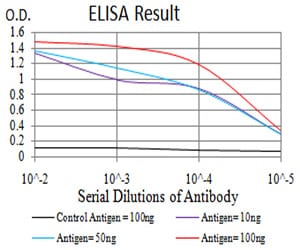
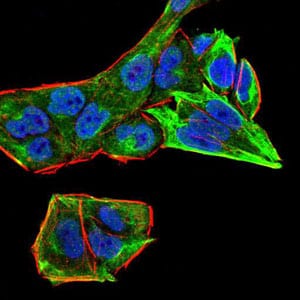
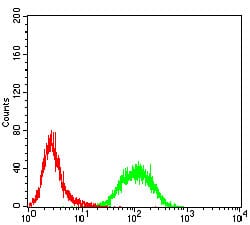
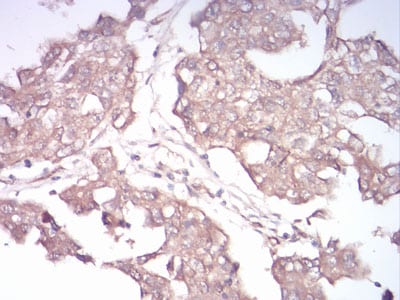
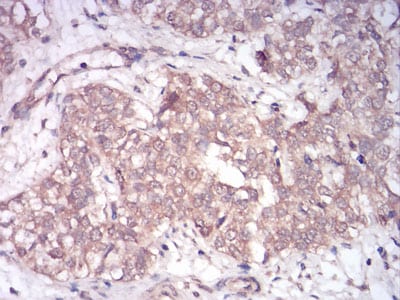
| WB | 咨询技术 | Human,Mouse,Rat |
| IF | 咨询技术 | Human,Mouse,Rat |
| IHC | 1/200 - 1/1000 | Human,Mouse,Rat |
| ICC | 1/200 - 1/1000 | Human,Mouse,Rat |
| FCM | 1/200 - 1/400 | Human,Mouse,Rat |
| Elisa | 1/10000 | Human,Mouse,Rat |
| Aliases | GIG4 |
| Entrez GeneID | 5872 |
| clone | 7G8A4 |
| WB Predicted band size | 22.8kDa |
| Host/Isotype | Mouse IgG1 |
| Antibody Type | Primary antibody |
| Storage | Store at 4°C short term. Aliquot and store at -20°C long term. Avoid freeze/thaw cycles. |
| Species Reactivity | Human |
| Immunogen | Purified recombinant fragment of human Rab13 (AA: 66-200) expressed in E. Coli. |
| Formulation | Purified antibody in PBS with 0.05% sodium azide |
+ +
以下是3-4篇关于Rab13抗体的文献概览(基于公开研究总结):
1. **文献名称**:*Rab13 regulates membrane trafficking between TGN and recycling endosomes in polarized epithelial cells*
**作者**:Marzesco AM, et al.
**摘要**:研究使用Rab13特异性抗体,揭示了Rab13在极化上皮细胞中调控跨膜蛋白从高尔基体(TGN)到循环内体的运输,并参与紧密连接形成。
2. **文献名称**:*Rab13 promotes metastasis by regulating endosomal trafficking in invasive cancer cells*
**作者**:Zhou Y, et al.
**摘要**:通过Rab13抗体进行免疫印迹和免疫荧光实验,发现Rab13通过增强EGFR等受体的循环运输,促进癌细胞侵袭和转移,与肿瘤预后不良相关。
3. **文献名称**:*Rab13 small GTPase regulates anterograde trafficking of vesicular stomatitis virus glycoprotein in epithelial cells*
**作者**:Sakane A, et al.
**摘要**:利用Rab13抗体验证其表达与定位,证明Rab13通过调控囊泡运输影响病毒糖蛋白的定向转运,揭示其在细胞膜极性维持中的作用。
4. **文献名称**:*Characterization of Rab13 antibodies for intracellular trafficking studies*
**作者**:Köhler K, et al.
**摘要**:对比多种Rab13抗体的特异性与适用性,验证其在免疫沉淀(IP)和免疫组化(IHC)中的可靠性,为后续功能研究提供工具支持。
(注:以上文献为领域内代表性研究方向的概括性总结,具体引用请以实际论文信息为准。)
Rab13 antibody is a research tool used to detect and study Rab13. a small GTPase belonging to the Ras superfamily of proteins. Rab GTPases are critical regulators of intracellular membrane trafficking, vesicle transport, and organelle dynamics. Specifically, Rab13 localizes to recycling endosomes, tight junctions, and the plasma membrane, where it plays roles in cell-cell adhesion, cell polarity, and directional migration. It is implicated in processes such as epithelial barrier formation, neurite outgrowth, and cancer cell metastasis by modulating the trafficking of adhesion molecules (e.g., occludin, claudins) and integrins.
Antibodies against Rab13 enable researchers to investigate its expression, localization, and function through techniques like Western blotting, immunofluorescence, and immunoprecipitation. These antibodies are often raised in hosts such as rabbits or mice, targeting specific epitopes within the Rab13 protein (e.g., N-terminal or C-terminal regions). Validation typically includes knockout controls or siRNA-mediated knockdown to confirm specificity.
Rab13 dysregulation has been linked to pathological conditions, including cancer progression, neurological disorders, and impaired wound healing. Its overexpression in certain cancers correlates with enhanced invasiveness, making it a potential therapeutic target. Researchers also study Rab13 in developmental biology and epithelial-to-mesenchymal transition (EMT) models. Commercial Rab13 antibodies vary in clonality (monoclonal/polyclonal), conjugates (e.g., HRP, fluorescent tags), and species reactivity (human, mouse, rat), allowing flexibility in experimental design. Proper controls and validation remain essential due to occasional cross-reactivity with related Rab proteins.
×